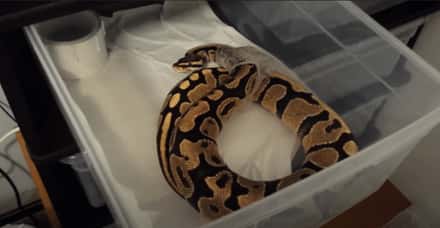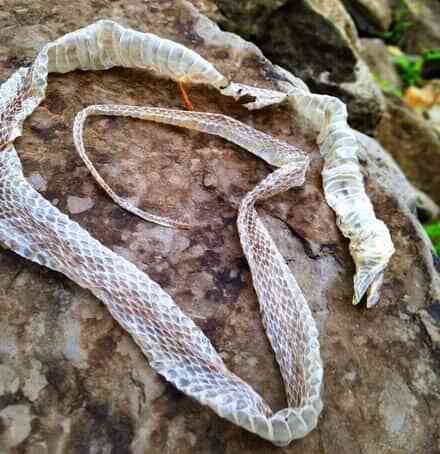
Snake shedding their skin has been one of the main concerns for the beginners who had just got their first pet snake. While I got my first snake I was also a bit worried for a couple of months regarding the shedding process. So to save you from the hassle, I have researched and shared what I have learned regarding some of the most asked queries of snakes shedding.
How often do snakes shed? On average, a snake sheds its skin every 5 to 11 weeks. The offspring of a snake tend to shed their skin every 4 to 6 weeks while the adult snake sheds every 8 to 12 weeks. The frequency of shedding depends on the health, age, humidity, feeding, and species of the snake.
The frequency of skin shedding in snakes is quite different at different stages of their life.
As their skin doesn’t grow with the growth of their body they need to shed their skin. Snakes tend to shade more when they are in a growing phase but the frequency changes when they become adults.
As the snake gets older there is a decline in the frequency of shedding. After getting to a certain age the growth of the snake stops and they only shed 2 to 3 times a year to get rid of the parasite and worn scales.
One more thing which I found very interesting is that snakes also shed the dead skin of their tongue. But this shedding process doesn’t occur while shedding their scales.
Other than this the frequency of shedding is directly proportional to the amount and consistency of the food that you feed to your pet snake. Snakes shed more if they are living in a humid environment, with a proper diet and a healthy body.
But what about the baby snakes, as they are pretty young they are undergoing rapid growth and hence they tend to shed more often. Sometimes this makes the owner anxious, as the baby snake sheds a lot more often. But here is what you need to know about the shedding of baby snakes.
How often do baby snakes shed?
A baby snake sheds every 4 to 6 weeks until they get to the age of 18 to 24 months old. As the baby snake undergoes frequent physical changes like an increase in weight and size. Their body continues to outgrow their skin, hence the younger snakes need to shed more often.
A young snake grows very quickly until they reach the age of 3-5 years. But the skin of the snakes doesn’t grow with their body due to which they need to shed their skin more frequently in order to allow further growth.
However, the shedding period I have mentioned should not be considered as the ultimate answer to the question. As different factors come into play while the process of shedding.
Sometimes the young snakes can even shed from a couple of times in a month to every 2 to 3 months and it completely varies for every snake.
But you can make the process of shedding a lot easier by knowing when your pet snake is going to shed and giving them some extra care and attention while shedding. Keep reading the article and I will tell you how to get the right sign to know that your snake is stepping towards the shedding process.
Sign, that your snake is going to shed
The process of shedding could be very stressful for your pet snake. By providing them a comfortable environment and correct humidity you can help them out in shedding much more easily.
Snakes undergo three stages in the process of shedding. The initial phase, Blue Phase, Final Phase. During the initial phase, you can identify these signs that indicate the snake is going to shed. I have listed some of the most prominent signs of snakes beginning to shed.
- The snake will refuse to eat or there will be a decline in their appetite. This will be the first indication that your pet snake is going to shed in a couple of weeks.
- They will hide in a close and humid enclosure and will act more aggressively. You should probably avoid handling as much as possible.
- The most common sign that your pet snake is going to shed in a couple of days, is their eyes turn cloudy or bluish in color. Due to which their vision gets opaque and they feel more vulnerable.
- The skin color of the snake becomes dull and their belly color changes to pink.
- It is not necessary that your snake shows all of these signs as it varies from species to species. It is totally perfect if you get any of this indication.
If the snake sheds in one single piece, it is a sign of good health.
As the snake will only shed in pieces when they are sick or their enclosure doesn’t have sufficient humidity.
So whenever you get an indication that your pet snake is going into the shedding phase. Then you should increase the humidity of their enclosure to ensure they carry out the shedding process more easily.
Additionally, it is also essential to know how long the shedding process will last. So you have a better understanding of what your pet snake is undergoing.
How long does it take for a snake to shed its skin?
The Snakes take 7 to 14 days to shed completely. The shedding process occurs in three stages: the initial phase lasts for 4 to 8 days. The blue phase lasts for 3 to 4 days, and the final phase occurs 1 to 2 days after the blue phase.

In the initial phase, the snake becomes aggressive and tends to hide in a close and humid enclosure. In this phase, they refuse to eat and their body starts to show signs of discoloration or dullness, and the belly of the snakes turns pink.
At the beginning of the blue phase, the skin of the snake becomes quite dull and their eye color becomes cloudy and greyish. While at the ending of the blue phase the eyes become clear and the snake comes to the normal.
In the final phase, the snake rubs its body to a rough surface and peels of the dead skin and crawls out of it. Once the shedding process is over you can provide them lukewarm water for soaking. To remove and leftover pieces of dead skin on their body.
Related Question
Do snakes shed close to where they live?
Snakes do not shed their skin near their shelter. As snakes are not territorial creatures they search for a suitable surface to rub and peel off their dead skin. And then crawl out of it thus, a snake shed doesn’t indicate a snake is living nearby.
Does it hurt snakes when they shed?
Shedding dead skin does not hurt the snakes. Because during the shedding process, a liquid layer of lymph, filled with air is formed between the old and new skin. Which completely separates the old skin from the snake’s body.
Do all snakes shed their skin?
All species of snake shed their skin. As the skin of snakes does not grow with the growth of their body. Every species of snake needs to shed their old skin 4 to 12 times a year to allow further growth.
